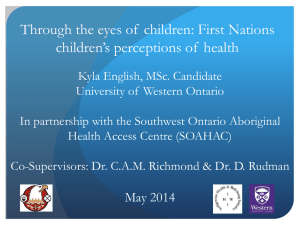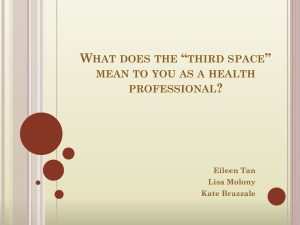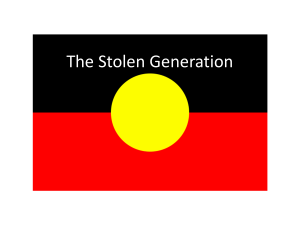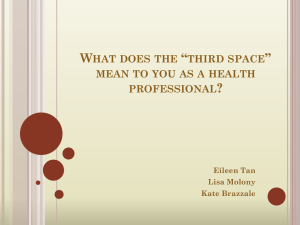What does the *third space* mean to you as a health professional?
advertisement
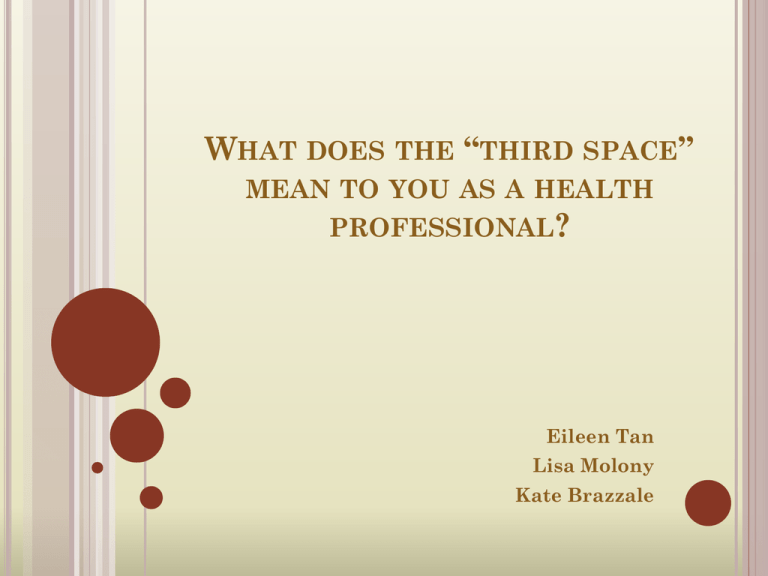
WHAT DOES THE “THIRD SPACE” MEAN TO YOU AS A HEALTH PROFESSIONAL? Eileen Tan Lisa Molony Kate Brazzale INTRODUCTION DEFINITION OF THIRD SPACE ABORIGINAL TERMS OF REFERENCE – THIRD SPACE Link with Identity Their Perceptual View/Way of Life How they deal with things – eg Community involvement. ABORIGINAL IDENTITY IN RELATION TO THE THIRD SPACE Family Community Land Importance ABORIGINAL HEALTH STATISTICS Life expectancies of Indigenous versus NonIndigenous Males and Females. 90 82.6 78.5 80 72.9 70 62.7 60 On average Indigenous Men die 11 years earlier then NonIndigenous Males Indigenous Females die 9 years earlier then NonIndigenous Females. Data from the Australian Bureau of Statistics 2005-2007 data surveys. 50 Indigenous Non - Indigenous 40 30 20 10 0 Males Females ABORIGINAL HEALTH STATISTICS Health complication Comparative incidence rate Comment Circulatory system 2 to 10-fold 5 to 10-fold increase in rheumatic heart disease and hypertensive disease, 2-fold increase in other heart disease, 3-fold increase in death from circulatory system disorders. Circulatory system diseases account for 24% deaths. Renal failure 2 to 3-fold 2 to 3-fold increase in listing on the dialysis and transplant registry, up to 30-fold increase in end stage renal disease, 8-fold increase in death rates from renal failure, 2.5% of total deaths. Communicable 10 to 70-fold 10-fold increase in tuberculosis, Hepatitis B and Hepatitis C virus, 20-fold increase in Chlamydia, 40-fold increase in Shigellosis and Syphilis, 70-fold increase in Gonococcal infections. Diabetes 3 to 4-fold 11% incidence of Type 2 Diabetes in Indigenous Australians, 3% in non-Indigenous population. 18% of total deaths. Cot death 2 to 3-fold Over the period 1999–2003, in Queensland, Western Australia, South Australia and the Northern Territory, the national cot death rate for infants was three times the rate of Non-Indigenous. Mental health 2 to 5-fold 5-fold increase in drug-induced mental disorders, 2-fold increase in diseases such as schizophrenia, 2 to 3-fold increase in suicide. 2-fold A 2-fold increase in cataracts. 60% increase in death rate 60% increased death rate from neoplasms. In 1999–2003, neoplasms accounted for 17% of all deaths. 3 to 4-fold 3 to 4-fold increased death rate from respiratory disease accounting for 8% of total deaths. Optometry/ Ophthalmology Neoplasms (Tumour) Respiratory ABORIGINAL HEALTH STATISTICS ABORIGINAL HEALTH STATISTICS Selected Chronic Conditions: Ratio of Indigenous Australian’s to Non-Indigenous Australians — 2004–05 ABORIGINAL HEALTH STATISTICS Diabetes Comparison between Indigenous and Non Indigenous 2005 Cardiovascular Comparison between Indigenous and Non Indigenous 2005 ABORIGINAL HEALTH STATISTICS IMPLICATIONS FOR HEALTH PROFESSIONALS Third Space “A place where Indigenous and Non-Indigenous people can come and work together without fear of prejudice from ‘baggage’.” An area of mutual respect between Indigenous and Non-Indigenous people where they can work collaboratively. Health Professionals need Knowledge. Understanding Towards both sides Willingness to be open Of roles and responsibilities Empathy Of where the other comes from; their “space” Accepting of differences Avoid stereotyping IMPLICATIONS FOR HEALTH PROFESSIONALS Aboriginal and Torres Strait Islanders are not the same. Discontinue use of out-dated, derogatory terminology. Half-caste, full-blood, quadroon, etc. Always use the terms Aboriginal Man/Woman/People or Torres Strait Islander Man/Woman/People. Aboriginal people mistrust people who offer services related to “protection” and “intervention. European colonisation. Government Policies post colonisation. The “Stolen Generation”. Government policy til 1969. “Keep your word.” Changes made. e.g. Kevin Rudd’s “Apology”. NSW Department of Community Services 2009 & National Disability Services WA 2009 IMPLICATIONS FOR HEALTH PROFESSIONALS Sensitive issues due to past Government policies have contributed to: • • • • • • • • • • • • • Dispossession of land Family fragmentation Mental health issues Social and emotional wellbeing issues Grief and loss issues • Self-harm and intentional injury • Over-representation of Suicide rates • Family and domestic violence issues • Loss of country • Loss of identity Poverty Racism Unemployment Poor health outcomes Poor education outcomes Below standard literacy and numeracy rates Alcohol and substance abuse/misuse Over-representation in the juvenile and criminal justice system NSW Department of Community Services 2009 & National Disability Services WA 2009 IMPLICATIONS FOR HEALTH PROFESSIONALS Respect Kinship Elders, The Land, Animals, Ancestors. “Sorry Business” Defines roles and responsibilities within the family. Ensure that extended family is included in important meetings or when making decisions. Gender responsibilities. Men’s Business – issues which have a male perspective within aboriginal culture. Women’s Business – issues which have a female perspective within aboriginal culture. NSW Department of Community Services 2009 & National Disability Services WA 2009 IMPLICATIONS FOR HEALTH PROFESSIONALS Language Originally 300 nations speaking 250 languages with up to 600 dialects. Nonverbal cues Eye contact. Hand and facial gestures. Silence Progression of Conversation. Semantic Ambiguity Swearing Communication Techniques Use uncomplicated language, Not “jargon”. Be wary of comprehension NSW Department of Community Services 2009 & National Disability Services WA 2009 CLOSE THE GAP CAMPAIGN Australia’s largest Campaign to improve Indigenous Health. Aimed at reduced the Life Expectancy Gap between Indigenous and Non Indigenous Australians to 0 years by 2031. OXFAM is campaigning to: Increase Aboriginal and Torres Strait Islanders’ access to health services Address critical social issues such as poor housing, nutrition, employment and education Build Indigenous control and participation in the delivery of health and other services Get governments at state and national level to work in partnership with Indigenous communities, health organisations and experts to develop and monitor a plan to tackle the Indigenous health crisis Promote real and meaningful partnerships between Indigenous COAG, 2011 and OXFAM 2006 NEED FOR EDUCATION To understand the needs of our Aboriginal or Torres Strait Islander Patients Downing and Kowal 2011 The majority of Aboriginal people access health care from NonAboriginal services. Majority of Nurses interviewed felt that didn’t receive enough cultural training to look after Aboriginal and Torres Strait Islander patients They felt that they weren't giving them the level of care the needed and deserved. Canada’s Approach Kilpatrick, 2004 Looked at the need for Aboriginal Education. FOCUS QUESTION. REFERENCES


